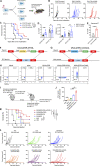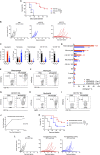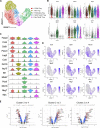OX40L-expressing recombinant modified vaccinia virus Ankara induces potent antitumor immunity via reprogramming Tregs
- PMID: 37145142
- PMCID: PMC10165539
- DOI: 10.1084/jem.20221166
OX40L-expressing recombinant modified vaccinia virus Ankara induces potent antitumor immunity via reprogramming Tregs
Abstract
Effective depletion of immune suppressive regulatory T cells (Tregs) in the tumor microenvironment without triggering systemic autoimmunity is an important strategy for cancer immunotherapy. Modified vaccinia virus Ankara (MVA) is a highly attenuated, non-replicative vaccinia virus with a long history of human use. Here, we report rational engineering of an immune-activating recombinant MVA (rMVA, MVA∆E5R-Flt3L-OX40L) with deletion of the vaccinia E5R gene (encoding an inhibitor of the DNA sensor cyclic GMP-AMP synthase, cGAS) and expression of two membrane-anchored transgenes, Flt3L and OX40L. Intratumoral (IT) delivery of rMVA (MVA∆E5R-Flt3L-OX40L) generates potent antitumor immunity, dependent on CD8+ T cells, the cGAS/STING-mediated cytosolic DNA-sensing pathway, and type I IFN signaling. Remarkably, IT rMVA (MVA∆E5R-Flt3L-OX40L) depletes OX40hi regulatory T cells via OX40L/OX40 interaction and IFNAR signaling. Single-cell RNA-seq analyses of tumors treated with rMVA showed the depletion of OX40hiCCR8hi Tregs and expansion of IFN-responsive Tregs. Taken together, our study provides a proof-of-concept for depleting and reprogramming intratumoral Tregs via an immune-activating rMVA.
© 2023 Yang et al.
Conflict of interest statement
Disclosures: L. Deng, N. Yang, Y. Wang, G. Mazo, J. D. Wolchok, and T. Merghoub reported a patent US20220056475A1 Application Number: 17/275,974 (filed by Memorial Sloan Kettering Cancer Center and licensed to IMVAQ Therapeutics). L. Deng, N. Yang, J. D. Wolchok, T. Merghoub, W. Yan, and J. Choi are co-founders of IMVAQ Therapeutics and have equity in IMVAQ Therapeutics. L. Deng reported grants and personal fees from IMVAQ Therapeutics during the conduct of the study. N. Yang reported personal fees from IMVAQ Therapeutics during the conduct of study. W. Yan reported personal fees from IMVAQ during the conduct of the study and personal fees from Sound Biologics outside the submitted work. J. Choi is an employee of IMVAQ Therapeutics during the conduct of the study. C.M. Rice has been a scientific advisor for IMVAQ, which has an interest in the material presented in this paper. J. D. Wolchok reported personal fees from IMVAQ Therapeutics during the conduct of the study; personal fees from Apricity Therapeutics, Ascentage Pharma, AstraZeneca, Bicara Therapeutics, Boehringer Ingelheim, Bristol Myers Squibb, Chugai, Daiichi Sankyo, Dragonfly, Georgiamune, Larkspur, Linneaus, Psioxus, Recepta, Tizona Therapeutics, Trishula, and Sellas; grants from Bristol Myers Squibb and Sephora; and “other” from Maverick and Xenimmune outside the submitted work. In addition, J. D. Wolchok had a patent to xenogeneic DNA vaccines with royalties paid, a patent to Newcastle Disease viruses for Cancer Therapy with royalties paid, a patent to myeloid-derived suppressor cell (MDSC) assay with royalties paid, a patent to prediction of responsiveness to treatment with immunomodulatory therapeutics and method of with royalties paid, a patent to monitoring abscopal effects during such treatment with royalties paid CellCarta, a patent to anti-CTLA4 antibodies licensed Agenus, a patent to anti-PD1 licensed Agenus, and a patent to anti-GITR licensed Agenus/Incyte. T. Merghoub is a consultant for Leap Therapeutics, Immunos Therapeutics, and Pfizer; and has grants from Bristol-Myers Squibb, Surface Oncology, Kyn Therapeutics, Infinity Pharmaceuticals, Peregrine Pharmeceuticals, Adaptive Biotechnologies, Leap Therapeutics, and Aprea. T. Merghoub is an inventor on patent applications related to work on oncolytic viral therapy, alphavirus-based vaccines, neo-antigen modeling, CD40, GITR, OX40, PD-1, and CTLA-4. No other disclosures were reported.
Figures















References
-
- Chen, A.I., McAdam A.J., Buhlmann J.E., Scott S., Lupher M.L. Jr, Greenfield E.A., Baum P.R., Fanslow W.C., Calderhead D.M., Freeman G.J., and Sharpe A.H.. 1999. Ox40-ligand has a critical costimulatory role in dendritic cell:T cell interactions. Immunity. 11:689–698. 10.1016/S1074-7613(00)80143-0 - DOI - PubMed
Publication types
MeSH terms
Substances
Supplementary concepts
Grants and funding
LinkOut - more resources
Full Text Sources
Other Literature Sources
Medical
Molecular Biology Databases
Research Materials

